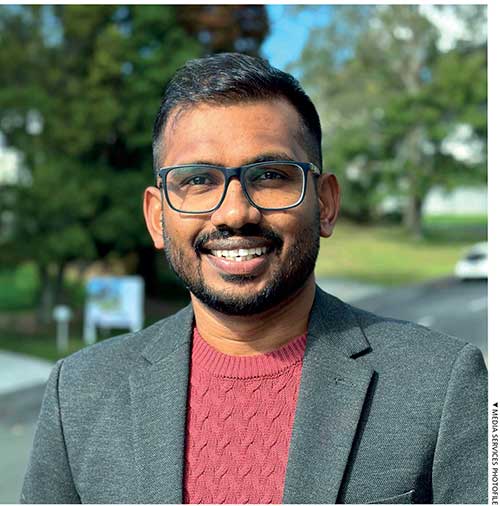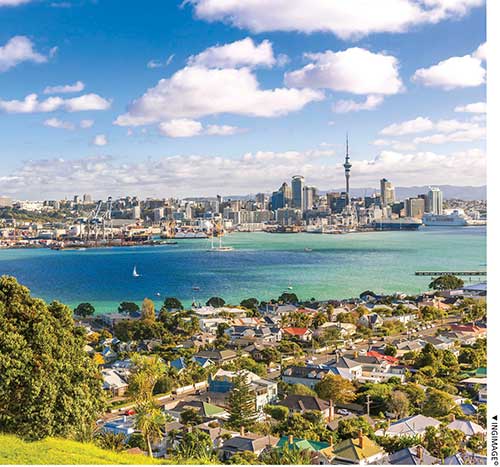Dr. Iresh Jayawardena
Planning for sustainability

Specialising in climate change adaptation, regenerative urban development and disaster risk mitigation, Dr. Iresh Jayawardena counts over a decade of academic and practical experience, through which he has made significant contributions to transformative urban resilience and policy initiatives, in both New Zealand and Sri Lanka.
In this exclusive interview, Jayawardena highlights the main challenges Sri Lanka faces in urban planning and development – and he points to New Zealand’s approach as a model for sustainable and resilient development.
Q: What are the main challenges in urban planning and development in Sri Lanka – and how do they compare with those in New Zealand?
A: Sri Lanka faces several challenges that are both unique and somewhat similar to those in New Zealand.
In Sri Lanka, rapid urbanisation especially in the Western Province has resulted in congestion, inadequate infrastructure, social inequality and unplanned development. In contrast, New Zealand – particularly Auckland – strives for more sustainable urban growth through policies that encourage intensification.
Both countries deal with risks from natural disasters, highlighting the need for effective urban resilience strategies.
Environmental sustainability is another shared concern. Sri Lanka requires major improvements in pollution control, biodiversity preservation and waste management, while New Zealand focusses on reducing carbon emissions, mitigating environmental impacts and enhancing green infrastructure through legislative measures.
Social equity is a critical issue as well with Sri Lanka’s urban development often neglecting lower income groups while New Zealand is actively incorporating local indigenous (Māori) perspectives and stakeholder engagement to promote inclusivity.
Governance and policy implementation effectiveness further distinguish the two nations with Sri Lanka facing fragmented governance that hampers coordinated development efforts, compared to New Zealand’s more organised yet challenging policy alignment across various levels of government.

Q: Based on your experience in New Zealand, what urban planning practices or policies do you think could be beneficial if implemented in Sri Lanka?
A: New Zealand prioritises sustainable resource management and urban development, which could offer insights.
Promoting energy efficient construction, integrating renewable energy and developing green infrastructure could greatly reduce Sri Lanka’s carbon footprint and improve building resilience.
Establishing systems to collect and analyse urban data would enable Sri Lankan cities to make more informed planning decisions, enhancing resource allocation and urban service delivery. Investing in strong digital infrastructure and connectivity would foster innovation, and elevate the quality of life in cities.
Additionally, focussing on ‘placemaking’ initiatives to revitalise underutilised areas into lively community spaces could enhance urban liveability. A more integrated approach that aligns various planning instruments – such as land use, transportation and infrastructure – would facilitate coherent urban development in Sri Lanka.
Creating national level urban design guidelines akin to New Zealand’s Urban Design Protocol could establish a consistent framework for quality urban design across Sri Lankan cities.
While these practices have proven effective in New Zealand, it’s essential to adapt them to Sri Lanka’s unique cultural, economic and environmental context.
Q: How can public-private partnerships (PPPs) be leveraged to advance urban planning and development projects in Sri Lanka?
A: The government could explore introducing incentives for private sector participation in adopting resilient design principles for new developments. For instance, PPPs can play a crucial role in delivering essential infrastructure such as affordable housing, public transport systems and waste management facilities.
A key advantage of PPPs is the ability to share risks between the public and private sectors. In complex urban development initiatives, risks associated with financing, construction delays or market demand can be significant. The government can collaborate with private investors to mitigate them while ensuring that projects align with broader public policy goals.
New Zealand has also utilised PPPs in the renewable energy sector. By involving private investors in developing solar, wind and hydropower facilities, the government can expedite the transition to cleaner energy while reducing the nation’s energy costs.

Q: In transport sector planning, what are the main challenges Sri Lanka faces – and how can urban planners address congestion and public transport inefficiencies?
A: The transport sector in Sri Lanka – especially in urban areas like Colombo – is facing several challenges that affect the quality of life, economic productivity and environmental sustainability.
Key issues include traffic congestion, inadequate public transport systems, limited infrastructure capacity and an overreliance on private vehicles. The lack of alternative transportation options compels many individuals to depend on cars, three wheelers or motorcycles, worsening the situation.
To alleviate congestion, a key strategy is to enhance the efficiency and attractiveness of public transport. This could include modernising bus and rail systems through investments in newer energy efficient vehicles and upgrading outdated infrastructure.
Improving the reliability, frequency and comfort of public transport services will likely encourage increased usage, particularly during peak hours. Implementing digital ticketing systems, real-time tracking apps and enhanced passenger information systems can improve the overall commuter experience.
Additionally, integrating land use planning with transport infrastructure through transit oriented development (TOD) can reduce congestion and promote public transport usage.
Urban planners should also advocate for non-motorised transport options such as cycling and walking. Creating safe and well designed pedestrian pathways and dedicated cycling lanes can decrease the number of short car trips, alleviating congestion.
PPPs can be instrumental in developing these transport infrastructure and services. By engaging private sector partners in transport projects, the government can access external expertise and funding, ensuring the expansion and upkeep of public transport systems.
Q: Given Sri Lanka’s vulnerability to natural disasters, how should urban planning incorporate disaster risk mitigation?
A: With the increasing frequency and severity of climate related disasters, proactive planning is vital to safeguarding people and infrastructure, ensuring resilience and promoting sustainable development.
In Sri Lanka, hazard mapping and risk assessments should be essential tools for urban planners to identify high-risk areas. This can guide zoning laws, land use policies, and the placement of critical infrastructure like hospitals, schools and transport systems.
By investing in modern technologies like geographic information systems (GIS) and remote sensing, Sri Lanka can enhance its risk assessment capabilities, allowing for more accurate mapping of vulnerable areas. This will help ensure that development is restricted or adapted in high-risk zones.
Post-disaster urban planning should prioritise the concept of ‘building back better,’ incorporating lessons learned from previous incidents to mitigate future damage.
Strengthening building codes and planning regulations to include disaster resilience is crucial for reducing urban vulnerability. In Sri Lanka, enforcing building codes should ensure that structures are designed to withstand regional hazards such as floods or landslides.
Following the 2011 earthquake, Christchurch emerged as a global leader in resilient urban design, prioritising green spaces, water management and flexible building standards. Its rebuilding efforts incorporated nature based solutions such as river corridors and green belts to mitigate flood risks.
Sri Lanka can adopt similar strategies, ensuring that new urban developments are designed with disaster resilience in mind by creating buffer zones, preserving natural ecosystems and retrofitting vulnerable infrastructure.
In addition, Sri Lanka can bolster its disaster response capacity by enhancing community engagement, investing in public education on disaster preparedness and ensuring that emergency infrastructure is readily accessible.

FACT FILE
FAMILY
Spouse – Thilini Wickramasinghe
Son – Mansara Jayawardena
SCHOOLING
Mayurapada Central College
HIGHER EDUCATION
BSc – University of Moratuwa
MSc – University of Sri Jayewardenepura
PRESENT OCCUPATION
Lecturer in Urban Planning – University of Auckland
COUNTRY OF RESIDENCE
New Zealand
CITY OF RESIDENCE
Auckland
PERSONAL PROFILE
Dr. Iresh Jayawardena is a lecturer in urban planning at the University of Auckland, specialising in climate change adaptation, regenerative urban development and disaster risk mitigation. With over 13 years of academic and practical experience, he has made significant contributions to transformative urban resilience and policy initiatives, in both New Zealand and Sri Lanka. His research emphasises the integration of global best practices into local planning contexts, particularly regarding socio-ecological matters. Jayawardena is a full member of the New Zealand Planning Institute (NZPI) and actively participates in international research collaborations aimed at incorporating environmental sustainability into urban planning. His teaching, research and professional practice are dedicated to promoting equitable and resilient urban development.
SRI LANKA SWOT ANALYSIS
STRENGTHS
Geostrategic location
Rich natural resources and biodiversity
Resilient human capital
WEAKNESSES
Political instability and governance issues
Economic vulnerabilities
Inadequate infrastructure
OPPORTUNITIES
Growth in tourism and hospitality
Expansion of renewable energy
Technology and digital economy
THREATS
Climate change and environmental degradation
Geopolitical tensions and external dependencies
Economic instability and debt servicing
